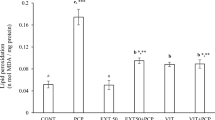Abstract
Alcoholic extract of the marine algae Chlorella vulgaris was examined for its free radical scavenging effect with reference to naphthalene-induced lipid peroxidation in serum, liver, and kidney of rats. Initially, upon naphthalene intoxication (435 mg/kg body weight, intraperitoneally), the lipid peroxidation activity increased significantly (P < 0.001), and in contrast, the enzymic antioxidants (superoxide dismutase, catalase, glutathione peroxidase) and non-enzymic antioxidants (glutathione, ascorbic acid, and α-tocopherol) levels decreased remarkably. When the naphthalene stressed rats were treated with Chlorella vulgaris extract (70 mg/kg body weight, orally), the lipid peroxidation activity reduced significantly (P < 0.001) and the activities of both the enzymic and non-enzymic antioxidants increased reaching near control values. The minimum concentration (70 mg/l) of the extract that exhibited maximum (85%) free radical scavenging activity was chosen for the experimental study. The present results suggest that Chlorella vulgaris extract exerts its chemo-preventive effect by modulating the antioxidants status and lipid peroxidation during naphthalene intoxication.

Similar content being viewed by others
References
Vijayavel K, Gomathi RD, Durgabhavani K, Balasubramanian MP (2004) Sublethal effect of naphthalene on lipid peroxidation and antioxidants status of the marine edible crab Scylla serrata. Mar Pollut Bull 48:429–433
Wilson AS, Davis CD, Williams DP, Buckpitt AR, Pirmohamed M, Park BK (1996) Characterisation of the toxic metabolite(s) of naphthalene. Toxicology 114:233–242
Vuchetich PJ, Bagchi D, Bagchi M, Hassoun EA, Tang L, Stohs SJ (1996) Naphthalene-induced oxidative stress in rats and the protective effects of vitamin E succinate. Free Radic Biol Med 21(5):577–590
Greene JF, Zheng J, Grant DF, Hammock BD (2000) Cytotoxicity of 1,2-epoxynaphthalene is correlated with protein binding and in situ glutathione depletion in cytochrome P4501A1 expressing Sf-21 cells. Toxicol Sci 53:352–360
Stohs SJ, Ohia S, Bagchi D (2002) Naphthalene toxicity and antioxidant nutrients. Toxicology 180:97–105
Vijayavel K, Anbuselvam C, Balasubramanian MP (2005) Naphthalene-induced hematological disturbances and oxidative stress in an estuarine edible crab, Scylla serrata. Environ Toxicol 20:464–466
Konishi F, Tanaka K, Himeno K, Taniguchi K, Nomoto K (1985) Antitumor effect induced by a hot water extract of Chlorella vulgaris (CE): resistance to Meth-A tumor growth mediated by CE-induced polymorphonuclear leukocytes. Cancer Immunol Immunother 19:73–78
Morimoto T, Nagatsu A, Murakami N, Sakakibara J, Tokuda H, Nishino H (1995) Anti-tumor-promoting glyceroglycolipids from the green alga, Chlorella vulgaris. Phytochemistry 40:1433–1437
Singh A, Singh SP, Bamezai R (1998) Perinatal influence of Chlorella vulgaris (E-25) on hepatic drug metabolizing enzymes and lipid peroxidation. Anticancer Res 18(3A):1509–1514
Tanaka K, Koga T, Konishi F, Nakamura M, Mitsuyama K, Nomoto K (1986) Augmentation of host defense by a unicellular green alga, Chlorella vulgaris, to Escherichia coli infection. Infect Immun 53:267–271
Hasegawa T, Okuda M, Makino M, Hiromatsu K, Nomoto K, Yoshikai Y (1995) Hot water extracts of Chlorella vulgaris reduce opportunistic infection with Listeria monocytogenes in C57BL/6 mice infected with LP-BM5 murine leukemia viruses. Int J Immunopharmacol 17:505–512
Shibata S, Oda K, Onodera-Masuoka N, Matsubara S, Kikuchi-Hayakawa H, Ishikawa F, Iwabuchi A, Sansawa H (2001) Hypocholesterolemic effects of indigestible fraction of Chlorella regularis in cholesterol-fed rats. J Nutr Sci Vitaminol 47:373–377
Shibata S, Natori Y, Nishhara T, Tomisaka K, Matsumoto K, Sansawa H, Nguyen VC (2003) Antioxidant and anti-cataract effects of Chlorella on rats with streptozocin-induced diabetes. J Nutri Sci Vitaminol 49:334–339
Hashimoto S, Setoyama T, Yokokura T, Mutai M (1982) Effects of soybean phosphilid, chlorella phospholipid and clofibrate on collagen and elastin synthesis in the aorta and on the serum and liver lipid contents in rats. Exp Mol Pathol 36:99–106
Abe N, Murata T, Hirota A (1998) Novel 1,1-diphenyl-2-picrylhydrazyl-radical scavengers, bisorbicillin and demethyltrichodimerol, from a fungus. Biosci Biotechnol Biochem 62:661–662
Lowry OH, Rosebrough NJ, Farr AL, Randall RJ (1951) Protein measurement with the folin-ciocalteau reagent. J Biol Chem 193:265–273
Okawa H, Ohishi N, Yagi K (1979) Assay for lipid peroxides in animal tissues by thiobarbituric acid reaction. Anal Biochem 95:351–358
Marklund S, Marklund G (1974) Involvement of superoxide anion radical in the auto-oxidation of pyrogallol and a convenient assay of superoxide dismutase. Eur J Biochem 47:469–474
Sinha AK (1972) Coliometric assay of catalse. Anal Biochem 47:389–395
Rotruck JT, Pope AL, Ganther HE, Swanson AB, Hafeman DG, Hoekstra WG (1973) Selenium: biochemical role as a component of glutathione peroxidase. Science 179:588–590
Moron M, Depierre JW, Mannervik BT (1979) Levels of glutathione, glutathione reductase and glutathione S-transferase activities in rat lung and liver. Biochem Biophys Acta 582:67–78
Omaye ST, Turnbull JB, Sauberlich HE (1979) Selected methods for the determination of ascorbic acid in animal cells, tissues and fluids. Methods Enzymol 62:1–11
Desai ID (1984) Vitamin E analysis method for animal tissues. Methods Enzymol 105:138–143
Pandya U, Saini MK, Jin GF, Awasthi S, Godley BF, Awasthi YC (2000) Dietary curcumin prevents ocular toxicity of naphthalene in rats. Toxicol Lett 115(3):195–204
Vijayavel K, Anbuselvam C, Balasubramanian MP (2006) Free radical scavenging activity of the marine mangrove Rhizophora apiculata bark extract with reference to naphthalene induced mitochondrial dysfunction. Chem Biol Inter 163(1–2):170–175
Ramanathan K, Balakumar BS, Panneerselvam C (2002) Effects of ascorbic acid and α-tocopherol on arsenic-induced oxidative stress. Hum Exp Toxicol 21:675–680
Miranda MS, Sato S, Mancini-Filho J (2001) Antioxidant activity of the microalga Chlorella vulgaris cultured on special conditions. Boll Chim Farm 140:165–168
Kudaa T, Tsunekawaa M, Gotoa H, Arakib Y (2005) Antioxidant properties of four edible algae harvested in the Noto Peninsula, Japan. J Food Comp Anal 18:625–633
Wu LC, Ho JAA, Shieh MC, Lu IW (2005) Antioxidant and antiproliferative activities of Spirulina and Chlorella water extracts. J Agric Food Chem 53:4207–4212
Author information
Authors and Affiliations
Corresponding author
Rights and permissions
About this article
Cite this article
Vijayavel, K., Anbuselvam, C. & Balasubramanian, M.P. Antioxidant effect of the marine algae Chlorella vulgaris against naphthalene-induced oxidative stress in the albino rats. Mol Cell Biochem 303, 39–44 (2007). https://doi.org/10.1007/s11010-007-9453-2
Received:
Accepted:
Published:
Issue Date:
DOI: https://doi.org/10.1007/s11010-007-9453-2




